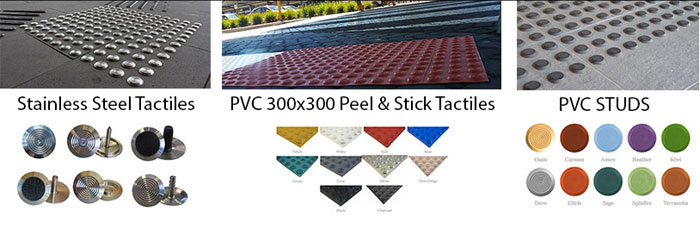Public spaces can be especially difficult for people with vision impairment to navigate safely as they are unfamiliar with the obstacles that may be present in their path.
Tactile Ground Surface Indicators (TGSIs) are tools designed to assist visually impaired people with navigating public spaces safely and easily. TGSIs work by enabling people to identify the pattern so that they can get used to these areas and navigate a path through which they can travel with ease.
TGSIs are mostly used in areas commonly referred to as ‘dangerous’ such as ferry terminals and wharves, train stations, bus stops, rail stops and depots, all of which can be quite hazardous for blind people to navigate through. Places such as curbs, stairs, platform edges and different kinds of obstacles are normally difficult to navigate, and the added crowd and noise will only make it tougher. Injuries or worse can happen if a visually-impaired person makes a mistake walking through these spaces.
Helping individuals with visual impairments to move through spaces more efficiently and confidently is very important, and TGSIs do this by providing orientation and alerting them to any potential hazards or obstacles on their path. For people with visual impairments, having luminous pointers on the ground can help in guiding them through the area. Tactile indicators also work to provide the blind with sensory detection through their feet.
Types of tactile indicators
Tactile indicators are of two types – directional tactiles and warning tactiles. TGSIs use stainless steel, plastic or ceramic finishes, and basically act as a discrete guidance system. Also, these products come in either individual or mat form varieties.
Directional Tactiles
Directional tactiles are used to guide visually impaired people through a safe path. Directional pointers are installed as long rectangular strips upon the floor surface. These directional tactiles are regularly used in public transport areas and for street crossings.
Warning Tactiles
Warning tactiles alert visually impaired individuals to an obstacle or hazard that stands in their way. Stairs, steps, escalators, wharves, railways and ramps use warning tactiles to protect the visually impaired from dangerous obstacles.
Installations in Australia
Australian regulations require commercial buildings to maintain compliance with the AS1428.4 standards for disabled access. Novaproducts Global only installs premium products from the TacAlert range, which comprises tactiles that have been manufactured for use in both interior and exterior spaces.
Novaproducts has installed more than 1000 TacAlert tactiles projects all over Australia. These tactiles are designed to provide optimum safety while adhering to all building code requirements. Ideal for both interior and exterior applications, the TacAlert range is very suitable for both new and existing structures. TacAlert PVC tiles offer an alternative option for providing safety to the visually impaired. These tactiles are designed with an oblique edge that allows safe installation as well as use by eliminating falls and trips in the areas where they are installed.
TacAlert tactiles are available in different colours to suit the aesthetic of the installation area.

Problems with TGSIs
Tactile surfaces help visually impaired people with safe mobility, allowing them to enjoy a good quality of life. However, there are a few problems that could come with TGSIs. The unevenness of tactile surfaces could prove problematic to people who have musculoskeletal diseases, or people with foot or lower limb deficiencies. Also, incorrectly located blocks could be problematic; for instance, warning blocks placed too far away from the obstacles or placed too close to the obstacles, not indicating the start or end of a stairway, as well as placing the blocks incorrectly at the entrance of crosswalks or doors can cause trips and falls.
In several locations in Australia, tactiles have been placed incorrectly at the entrances to doors or crosswalks. The tactile ground indicators are a welcome addition to safety procedures in place to help people with disabilities. However, if the blocks have not been installed correctly, then they cannot perform their job of guiding the visually impaired safely, which could end up placing these people in a dangerous situation.
3 factors to consider when choosing tactile ground indicators
- The tactiles must support the safe movement of visually impaired people.
- The installations should be easily detected and distinguished by visually impaired people.
- The installations consider people who are mobility impaired such as the elderly and wheelchair users.
The importance of TGSIs
All over the world, improvements are made every day to allow everyone to move and work easily. This applies very much to people with disabilities, which is why tactile ground surface indicators are essential in today’s world.
TSGIs create a safe barrier to guide the visually impaired through possibly dangerous areas. However, while the safe movement of visually impaired people is important, one should also ensure that these safety measures do not impede the movement of mobility impaired individuals.
One solution is to create several different lines of circulation for visually impaired people and wheelchair users, with the tactile ground surface indicators installed ahead of the stairs for the visually impaired and a slope installed for the mobility impaired. Tactile ground surface indicators have been designed to assist people with impaired vision to recognise their position, the hazardous places in their vicinity, as well as the direction they need to move in.
Therefore, they should be installed in safe areas and in a consistent manner that will help with easy identification by the visually impaired through contact with their feet. In Australia, these blocks are installed at rail station platforms, before exterior obstacles and highways, as well as at bus stops and airports. When used properly, tactile ground surface indicators could be of great assistance to people with visual impairments.

